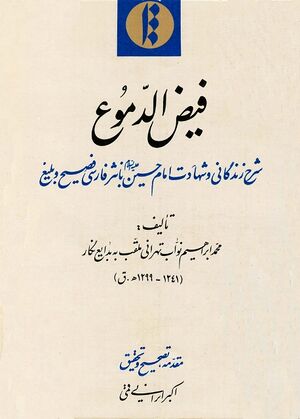Faiz al-Dumou Va Ibra al-Mustaham
 | |
| Author | Badaie Negar Tehrani |
|---|---|
| Original title | فَیضُ الدُّمُوعِ و عَبْرَةُ المُسْتَهام |
| Subject | Maqtal |
Faiz al-Dumou Va Ibra al-Mustaham, (َArabic: فَیضُ الدُّمُوعِ و عَبْرَةُ المُسْتَهام) written by Badaie Negar Tehrani, is a Maqtal about Imam Hussain and his sufferings.
About the book[edit | edit source]
"Faiz al-Dumou Va Ibra al-Mustaham" (means sad weeping and broken hearts) is written by Mirza Mohammad Ebrahim Navab Badaie Nagar Tehrani (1299-1241 AH).[1] There are two manuscripts of this book, one in the Golestan library with the date of writing in 1283 AH and the other in the Library, Museum and Document Center of the Islamic Consultative Assembly, written by Mirza Mohammad Reza Kalhor in 1286 AH. In the beginning and at the end of the book, the author explains the reason, how the book was named, and the date of authorship,[2] but he has not mentioned anything about the version printed in 1283 AH. On the other hand, the short interval between the first and the second authorship reinforces the suspicion that both versions contain the exact text and the only difference between them is the explanation and meanings of the words and sentences of the text. The handwriting of Faiz al-Dumou is very legible and beautiful, and in this respect, it is considered one of the best manuscripts of the Qajar era. But the book does not have page numbers, and the text is not divided into chapters, sections and subsections. During the last several decades, Faiz al-Dumou has been published several times with the introduction of different people, one of the most famous of which is "Tashih Va Tahghigh" by Ali Akbar Irani.[3]
Book Abstract[edit | edit source]
The book begins with a short introduction by its author, Mohammad Reza Kalhor, in which it is said that the year of the writing was 1286 AD in Tehran, and the author's capital paid the cost of publishing the book. In the following, the author's introduction is given, in which approaching old age and preparing a piece of spiritual baggage for the hereafter is stated as his motivation for writing the book. Also, while glorifying the efforts made in recording hadiths related to the event of Ashura and the compilation of numerous books about Imam Hussain, Badaie Nagar criticizes the fact that the authors of those books have only limited themselves to expressing what the common people will listen to and cry over whether they understand it or not, While the spiritual reward is that everyone understands the meaning and seeks the truth.[4] Badaie Nagar's solution to this problem is to prepare a Maqtal based on the hadiths and reliable sources and express them.[5]
In the text, the author introduces the sources he used, the most important of which are Lohoof by Sayyed Ibn Tawus, Manaqib Ale Abi Talib by Ibn Shahr Ashub and Maqātil al-Ṭālibiyyīn by Abu l-Faraj al-Isfahani. He often quotes the Arabic text of hadiths and Arabic poems and examples. The number of such expressions is so significant in some cases that the book's text is practically bilingual. According to the above, the reader's expectation from this book is a scientific and narrative one in the style of previous Maqtals, and such an event has happened. Practically, from the narrative aspect, Faiz al-Dumou is also called Lohoofnameh.[6] This belief is because in his book, Badaie Negar did not mention any particular points in addition to what is in the original books regarding Imam Hussain's uprising, and he did not make such a claim. The goal of Badai Nagar was to present a new literary narrative of the event of Ashura and Imam Hussain's uprising.[7] The primary and essential feature of the book "Faiz al-Dumou Va Ibra al-Mustaham" is its writing style. The author deliberately wrote the book in question in a different literary style from similar texts. In such an innovation, Badaie Negar was utterly successful and wrote a text that created a new and essential development in Ashura literature and Maqtals regarding rhetoric and literary writing style.
Sources[edit | edit source]
- Badaie Negar Tehrani, Mohammad Ebrahim Navab, Faiz al-Dumou Va Ibra al-Mustaham by Mohammad Reza Kalhor, Tehran, 1286 AD
- Ahmad Shakernezhad, Moarefi Va Erae Gozideie Az Maghatel-e- Kohan-e- Farsi Va Masaeb-e- Emam Hussain (introducing and presenting a selection of the ancient Persian Maqtals and the sufferings of Imam Hussain (P.B.U.H)). Pian Magazine, No. 103, Fall 1389 SH
References[edit | edit source]
- ↑ Shakernezhad, p. 146
- ↑ Badaie Negar, p. 168
- ↑ Badaie Negar Tehrani, Mohammad Ebrahim Navab, Faiz al-Dumou Va Ibra al-Mustaham, edited and researched by Ali Akbar Irani, Qom: Hijrat Publications, 1374 SH
- ↑ Badaie Negar, pp. 5 and 6
- ↑ Badaie Negar, p.6
- ↑ Shakernezhad, pp. 144-146
- ↑ Badaie Negar, p.168